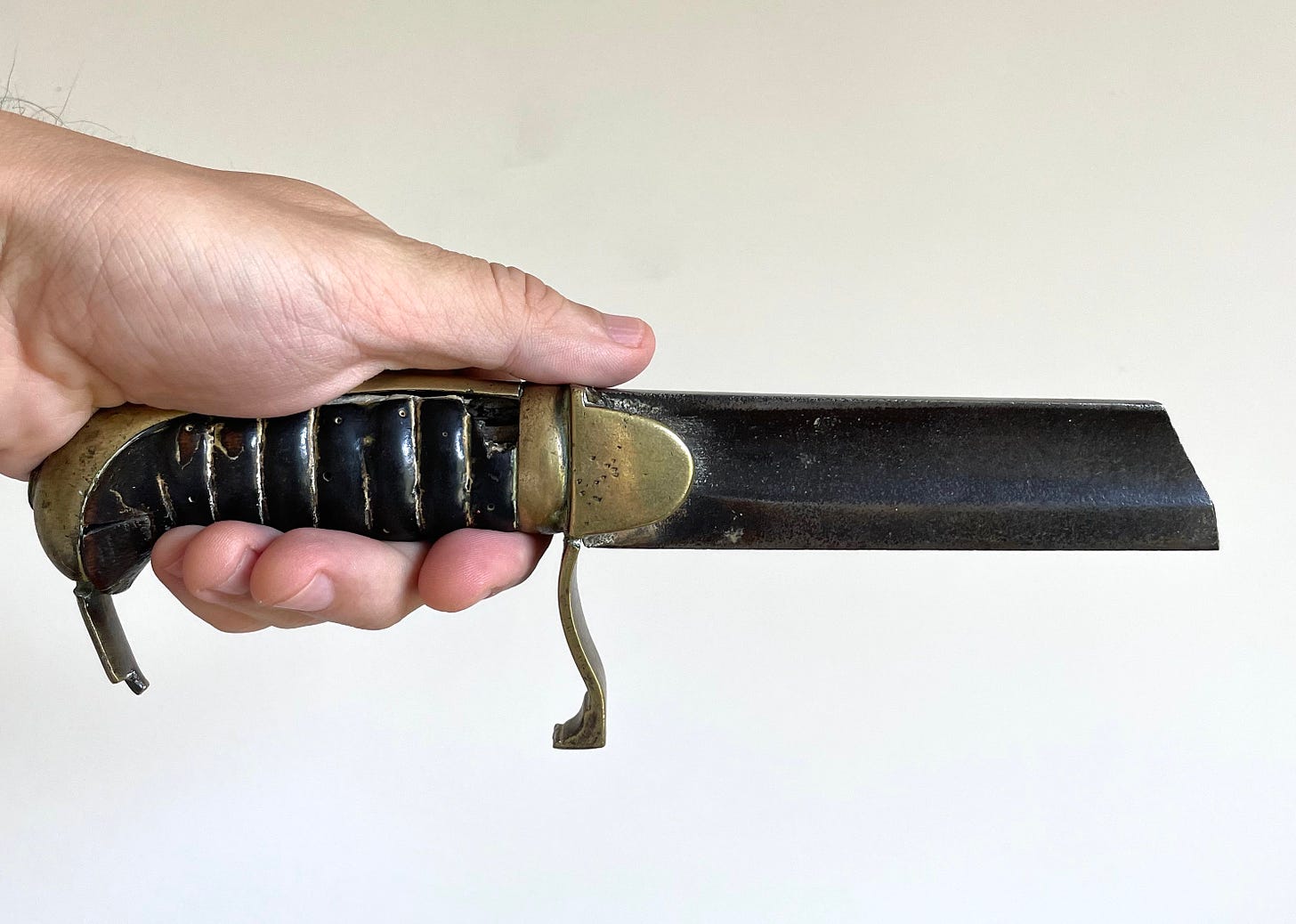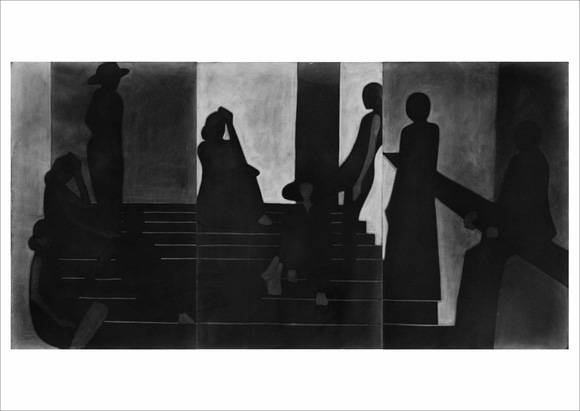My grandfather taught at a small elementary school just outside Rochdale, Lancashire (now Greater Manchester), on the edge of the Pennine Moors. He joined the staff in 1912, became headteacher in 1924, and retired in 1958. It was a long run, interrupted by mobilization for two world wars. People would bring him pieces of history and unusual items for safekeeping. Ex-pupils, ex-staff, locals, brought items to enrich the school. Shell collections, old air propellers with pictures painted on them, stuffed animals, coins, helmets, flags, fossils. One afternoon in the 1950s, an elderly man turned up at my grandparent’s home with a 33-inch-long curved blade sabre. My father, then a child, recalls that the man wore his hat and coat for the entire visit, and that he introduced himself as Mr Entwistle. Mr Entwistle said that the sabre been used by his grandfather at the Battle of Waterloo in 1815.
The ‘stirrup’ style knucklebow hand guard on the hilt was broken, and the sabre was missing its iron scabbard. Its ribbed wood and leather grip was riddled with worm-holes but polished to a rich black that set off the pale yellow brass guard. On the front end of the hilt were scratched the initials ‘K.E.’ The weapon was based on the Pattern 1796 Light Cavalry design, developed by British officer John Gaspard Le Marchant and cutler Henry Osborn. The blade—wider at the tip than at the hilt end, tapering on the distal edge—was intended for slashing and hacking from horseback. The curve allowed it to swing through the air rather than thrust. It was a notoriously vicious weapon.
My grandfather took the sabre off Mr Entwistle’s hands. It joined other swords, daggers and bayonets in the house. Years later, worried about burglars breaking in and arming themselves, my grandfather asked my father to bury all the bladed weapons in the garden. He interred them all in a flowerbed, except for the sabre. My father wanted to keep it, at least in token form, as a link to history, an echo through time. So he sawed off the blade, which went into the flowerbed, keeping the first five inches of it intact, and turned it into a good story. For decades it sat in the vicinity of my father’s desk, part ornament, part letter-opener. It was too dangerous for me to play with as a toy; the blade was blunt, but it had a nasty point on the tapered edge where the saw had gone through it.
Had it been used by Mr Entwistle’s grandfather at Waterloo? Do the calculations and it seems just about feasible that the 19th and 20th-century Entwistles could have crossed paths, one at the end of his life, the other at the start. But family lore may have merged a grandfather with a great-grandfather. The cavalry, which generally drew from society’s upper classes, may have been conflated with the yeomanry cavalry, or private militia, recruited from tenant farmers and new money landowners. And family shame may have made Waterloo a substitute for Peterloo.
On 16 August 1819, four years after Waterloo, a crowd of some 40-50,000 people gathered in St Peter’s Field, Manchester, for a political rally organized by radical orator Henry Hunt to demand parliamentary reform and universal suffrage. (‘Universal’ was taken to mean men, although Mary Fildes, campaigning for the right of women to vote, was an ally of Hunt and one of the speakers slated to address the crowd that day.) Under the ruling Conservative party, led by Lord Liverpool, there was widespread discontent in the country due to corruption, unemployment, rising food prices, and—this is all sounding familar—the upheavals of new industrial technology. The government feared insurrection and revolution spreading from France and was using the yeomanry to police unrest. On the orders of local magistrates who wanted Hunt and his associates arrested, the Manchester and Salford Yeomanry—undisciplined and reportedly drunk on the day—charged the crowd at St Peter’s Field on horseback, sabres drawn. As they ploughed into the rally, a woman was trampled and the toddler she was holding was killed. The paramilitaries immediately lost control of the situation and the army’s 15th Hussars were sent in as reinforcements along with the Cheshire Yeoman Cavalry and hundreds of special constables. Between 10 and 20 people were killed and reports estimate that some 400 to 700 people were injured. James Wroe, editor of the Manchester Observer newspaper, gave the massacre the bitter nickname ‘Peterloo.’
My father remembers a family of local landowners named Entwistle, but it was a common name in the northwest of England, and my father says he may have misunderstood or misheard how the man introduced himself. The sword fits the period, but the initials ‘K.E.’, scratched onto the hilt, is the only concrete information to go on if we were to consult historical registers or regimental lists. So it remains a mystery whether the weapon was used at Waterloo or Peterloo. Possibly neither, but I’m not letting go of a good story.
Earlier this year I brought the broken sabre with me to my apartment in New York, where it rests on a bookshelf between a pair of Roman-period earrings and a spotted conch shell. When I pick it up, the handle feels surprisingly light but the weight of the blade, despite its amputation, pulls downwards as if gravitating towards a point of balance that no longer exists, like a phantom limb, like a sword duelling with its ghosts.
RECOMMENDATIONS
—I don’t think you have enough girl groups of the French Occitan language pop scene in your life.
—Next weekend, the ICA London is dedicating its programming to La Clef Revival, who for three years occupied La Clef—an historical Parisian cinema which was closed down in 2018—until the police evicted them in March of this year. The cinephile group’s stated aim: “to keep on screening rare films, self-produced films, of all genres and formats, followed by discussions and drinks! But also workshops for young filmmakers and children, podcasts, a fanzine, concerts and many more surprises.”
—At Galerie Buchholz, New York, a tribute to the late Silke Otto-Knapp, from 28 October to 7 January.
—Thank you to Dena Beard, of The Lab in San Francisco, for putting me on to the venerable Chicago band ONO. Tent revival gospel, poetry, theatre, noise. They have a new single out next month titled Kate Cincinnati. Here they are in 1985.





